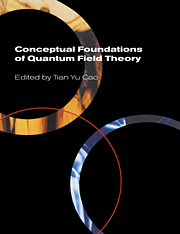Book contents
- Frontmatter
- Contents
- List of contributors
- Preface
- Photographs of the conference
- Introduction: Conceptual issues in quantum field theory
- Part One Philosophers' interest in quantum field theory
- Part Two Three approaches to the foundations of quantum field theory
- Part Three
- Part Four Mathematics, statistics and quantum field theory
- Part Five Quantum field theory and space-time
- Part Six
- Part Seven Renormalization group
- 18 What is fundamental physics? A renormalization group perspective
- 19 Renormalization group: an interesting yet puzzling idea
- Part Eight Non-Abelian gauge theory
- Part Nine The ontology of particles or fields
- Part Ten
- Name index
- Subject index
18 - What is fundamental physics? A renormalization group perspective
Published online by Cambridge University Press: 22 September 2009
- Frontmatter
- Contents
- List of contributors
- Preface
- Photographs of the conference
- Introduction: Conceptual issues in quantum field theory
- Part One Philosophers' interest in quantum field theory
- Part Two Three approaches to the foundations of quantum field theory
- Part Three
- Part Four Mathematics, statistics and quantum field theory
- Part Five Quantum field theory and space-time
- Part Six
- Part Seven Renormalization group
- 18 What is fundamental physics? A renormalization group perspective
- 19 Renormalization group: an interesting yet puzzling idea
- Part Eight Non-Abelian gauge theory
- Part Nine The ontology of particles or fields
- Part Ten
- Name index
- Subject index
Summary
The renormalization group, as embodied in the Callan-Symanzik equation, has had a profound impact on field theory and particle physics. You've heard from Ramamurti Shankar and Michael about some of its impact on condensed matter physics. I'd like to tell you my view of what the renormalization group has meant to practising condensed matter physicists.
What have we learned from renormalization theory? We learned that the detailed physics of matter at microscopic length scales and high energies is irrelevant for critical phenomena. Many different microscopic theories lead to exactly the same physical laws at a critical point. As Michael Fisher explained, one can even make precise quantitative predictions about certain ‘universal’ critical exponents without getting the microscopic physics right in detail. What is important is symmetry, conservation laws, the range of interactions, and the dimensionality of space. The physics of the diverging fluctuations at a critical point, which take place on scales of a micron or more, that's 104 angstrom, is largely ‘decoupled’ from the physics at angstrom length scales.
This story about scaling laws at a critical point tells us something about the meaning of a ‘fundamental physics’. Fundamental physics is not necessarily the physics of smaller and smaller length scales, to the extent that these length scales decouple from the physics that we're interested in at the moment. To elaborate on this point, I'd like to refer to a short paper, which influenced me a lot as a graduate student, that Ken Wilson wrote in 1972.
- Type
- Chapter
- Information
- Conceptual Foundations of Quantum Field Theory , pp. 264 - 267Publisher: Cambridge University PressPrint publication year: 1999



